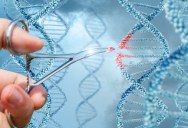Researchers Are Able To Remove HIV From Individual Cells

We have been in a battle with HIV since the 1980s (probably before, though we didn’t know it yet), and huge strides have been made as far as treating the disease.
Now, we may have made another leap toward curing it altogether.
That’s because scientists said they used CRISPR gene editing to cut away the “bad” bits of DNA affecting human cells with HIV.

More research is needed to determine whether or not this could be safe and effective in the long run, but scientists are hopeful this could push us along the path toward a cure.
Elena Herrera Carrillo, the lead on the project, issued a statement.
“We have developed an efficient combinatorial CRISPR-attack on the HIV virus in various cells and the locations where it can be hidden in reservoirs, and demonstrated that therapeutics can be specifically delivered to the cells of interest. These findings represent a pivotal advancement toward designing a cure strategy.”
CRISPR is a group of DNA sequences derived from bacteriophages. When they’re combined with an enzyme called Cas9, scientists can essentially cut and paste genes with results that are more than promising.

So far they’ve been able to make the human liver produce less cholesterol, restore color vision, and treat sickle cell disease.
Carrillo and her colleagues are trying to address the issue of dormant HIV DNA waking up while hiding in the human immune system.
Using CRISPR, they managed to disable the dormant virus in immune cells arranged on a dish.
There are still questions to be answered, like whether dormant HIV cells could infect cells in other areas of the body.

Also, they need to prove the procedure would be safe to try in actual humans, says University of Nottingham gene-therapy technologies associate professor James Dixon.
“Much more work will be needed to demonstrate results in these cell assays can happen in an entire body for a future therapy.
Still, proof that the concept works is definitely a reason to hope.
It will likely be some time before we know more, but this could definitely be big news.
If you thought that was interesting, you might like to read a story that reveals Earth’s priciest precious metal isn’t gold or platinum and costs over $10,000 an ounce!

Sign up to get our BEST stories of the week straight to your inbox.




